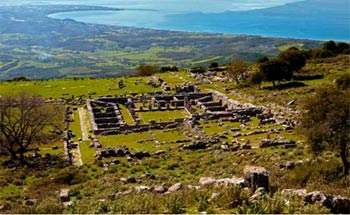Cassope
In an ideal location for climate and safety, on a plateau on the southern slopes of Mount Zalongo (height 550-560 m) with an incredible view towards the Ambracian Gulf, the peninsula and the Ionian Sea, Cassope was founded in the first half the fourth century BC as the political centre of Cassopaea and to protect the fertile plain to the south from being taken by the Helian colonists.

Description:
The city flourished until 168 BC, but a year later (167 BC) it was destroyed by the Romans. In the years that followed, a part of the city was inhabited by the surviving citizens until they were forced to abandon it and settle in Nicopolis (after 31 BC).
One of the largest in ancient Epirus, it was an organised city belonging to the Epirot tribes. Until the start of the fourth century BC, the Epirot tribes lived in towns; it was only later (the second half of the fourth century BC) that they began to build walled cities. Cassope was founded as part of the efforts to join together the scattered settlements in the area.
The city’s fortification
The city walls, approximately 3.5 m wide, were all built of local limestone using the polygonal method. They were necessary for defence against enemy invasions and lined only the vulnerable points (along the southwest side), while the boundaries that were protected by the steep rocks (northwest side) remained unfortified. A dividing wall was built for better protection along the southwest side, where the incline is very gentle, to prevent siege weapons from being transported to a point near the city. On the citadels, which were also walled, tanks were carved out of the rock to collect the rainwater necessary to keep the residents supplied with water in the case of a siege. Of the gates which led into the city, only the western gate (3 m wide) has been preserved in relatively good condition; it was at approximately the same level as the main road through the city. Although simple in its construction, it is distinctive because of its arched upper section, which is one of the oldest examples of an arched construction in ancient Greek architecture.
Town planning
Designed according to the Hippodamian plan (created by the Miletan architect Hippodamus), according to the model of earlier Ambracia, Cassope covered 40 hectares with 20 parallel roads (4.20 m wide) approximately 30 m apart. These were intersected by broader roads (6 m wide), forming approximately 60 blocks.
Private residences
In the blocks, covering an area of 230 square metres, there were around 600 different houses facing towards the south to keep them cool in the summer and warm in the winter, but also so the residents could enjoy the breathtaking view towards the Ionian Sea and the peninsula. The houses, in particular, stand out because of both their excellent construction and their functionality, with shared drainage channels and amazingly-constructed covered drains. Some of them had colonnaded courtyards, decorated with beautiful mosaic floors.


